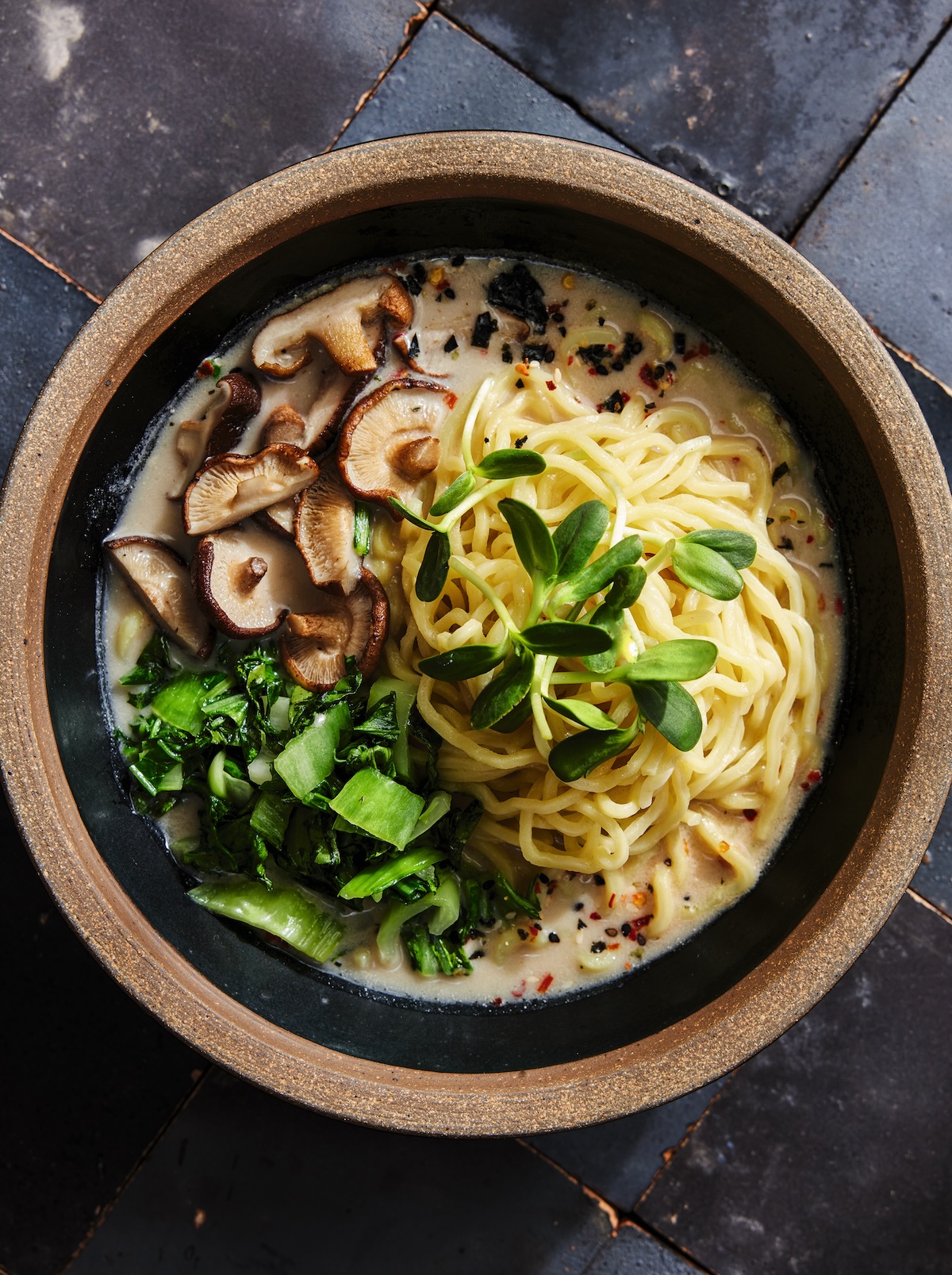Milky rich tonkotsu ramen is a Japanese noodle soup that many people swoon over. I have tasted many bowls, but the fatty pork broth and toppings can be a gut buster. I’ve never thought of creating a plant-based option, but Joe Yonan has one in his book, Mastering the Art of Vegan Cooking.
His recipe was inspired by creamy vegan ramen noodle soup prepared by Washington, D.C. chef Jonah Kim. The chef’s version employed Banrai brand of soy milk imported from Japan. Some grocery stores in Japan sell super creamy soy milk with a tiny envelope of coagulant for home cooks to whip up a batch of tofu. It’s a country serious about excellent tofu!

Wanting a less cheffy (read: homecook friendly) way to make the noodle soup, Joe tinkered with sunflower seeds and ended up crafting a sunflower milk to impart a similar kind of nutty richness to the ramen broth. To further spotlight sunflower seeds, an overlooked ingredient, he tops his bowl with sunflower sprouts. This is a brilliant, clever use of plants.
Why the recipe works
For tonkotsu broth, pork bones are simmered to release their umami and fatty richness in such a manner that everything gets suspended in the liquid. The opaque result is lip-smacking good.
In this recipe, you’re extracting the protein and fat from sunflower seeds to yield a rich, milky liquid. Unlike the pork broth there’s little actual cooking in this recipe. Most of the cooking is soaking time (passive cooking) to hydrate the seeds. After the seeds are well hydrated, ground, and squeezed, the resulting liquid is essentially the plant’s protein and fat suspended in water. Add that to broth and you have a tonkotsu-ish effect. Bingo!
Ingredient and equipment notes
Equipment: You’ll need a nut milk bag like this one for the sunflower seeds. It’s highly efficient for squeezing out the milk. If it’s unavailable, use a 24-inch square of unbleached muslin, which is better than cheesecloth.
Broth: Ideally you'd make stock from scratch but there's NOTHING wrong with buying a light, golden-hued vegetable broth to mimic the pork broth color and flavor. If that’s unavailable, use Better than Bouillon seasoned vegetable base.
Japanese ingredients: For the ramen noodles, Sun ramen noodles are sold fresh or frozen at Japanese and some Chinese and Korean markets. Dried ramen noodles would work fine! Regarding the shichimi togarashi, you can go fancy but this brand is fine!
Add-ins: If you’d like some extra protein or texture, include pan-fried tofu, cutting the pieces into chopstick-able pieces and simmering briefly in the broth before ladling into bowls. I'd fry up slabs (slice) or blocks (halve on the diagonal) using this method.
This is somewhat of a project recipe but there are plenty of weeknight, fast gratification recipes in Mastering the Art of Plant-Based Cooking. Get a copy of the book if you want a good global guide to vegan cuisine.
Creamy Sunflower Ramen
Ingredients
Broth
- 1 cup (140g) raw sunflower seeds, soaked in water for 8 to 12 hours, drained and rinsed
- 2 cups (470ml) water
- 6 cups (1.4L) lightly salted vegetable stock or broth
- 1 teaspoon fine sea salt, plus more as needed
Garnishes and ramen
- 12 ounces (340g) fresh shiitake mushrooms, stems composted (or saved for stock)
- 2 tablespoons sunflower oil Fine sea salt
- 1 pound (450g) baby bok choy, cored and thinly sliced crosswise
- 4 tablespoons Shichimi Togarashi
- 1 pound (450g) fresh ramen noodles, such as Sun Noodle brand, divided into 4 equal portions
- 1 cup (35g) lightly packed fresh sunflower sprouts
Instructions
- PREHEAT THE OVEN TO 400°F (200°C).
- Make the broth: In a high-powered blender, combine the soaked sunflower seeds and water and blend until very smooth, 30 seconds to 1 minute. Set a nut-milk bag in a bowl, pour in the sunflower milk, close the bag, and use your clean hands to extract as much of the liquid as possible, twisting and squeezing the bag over the bowl. (Compost the pulp, or save it to add to smoothies.
- In a large saucepan, combine the sunflower milk, vegetable stock, and salt, whisking to combine. Taste and add more salt if needed. Set over medium heat, and when the mixture is very hot but not bubbling, reduce the heat to low and cover to keep hot.
- Prepare the garnishes: On a large sheet pan, toss the shiitake caps with 1 tablespoon of the sunflower oil. Transfer to the oven and roast until tender, about 10 minutes. Leave the oven on. Transfer the mushrooms caps to a cutting board, cut into thick slices, and season lightly with salt.
- While the mushrooms are roasting, use a salad spinner to wash and thoroughly dry the baby bok choy.
- Transfer the bok choy to the same sheet pan you used for the mushrooms and toss with the remaining 1 tablespoon sunflower oil. Roast just until the greens wilt, about 3 minutes. Remove from the oven, season lightly with salt, and let the bok choy rest on the sheet pan.
- Cook the ramen: Bring a medium pot of salted water to a boil over high heat.
- Ladle ½ cup (120ml) of the hot broth into each of four deep bowls. Add 1 tablespoon of the shichimi togarashi to the bottom of each bowl.
- Add one portion (4 ounces /115g) of ramen noodles to the boiling water. Cook until barely tender, 30 to 90 seconds. Use a spider sieve or slotted spoon to lift the noodles from the water, holding them over the pot to drain, then transfer them to one of the bowls. Repeat with the remaining noodles.
- Divide the remaining hot broth among the bowls. (If it has separated or slightly curdled, don’t worry: Just whisk it for a few seconds, and it’ll come back together.) Top each bowl with mushrooms, roasted bok choy, and sunflower sprouts. Serve hot.



















Leave a Reply